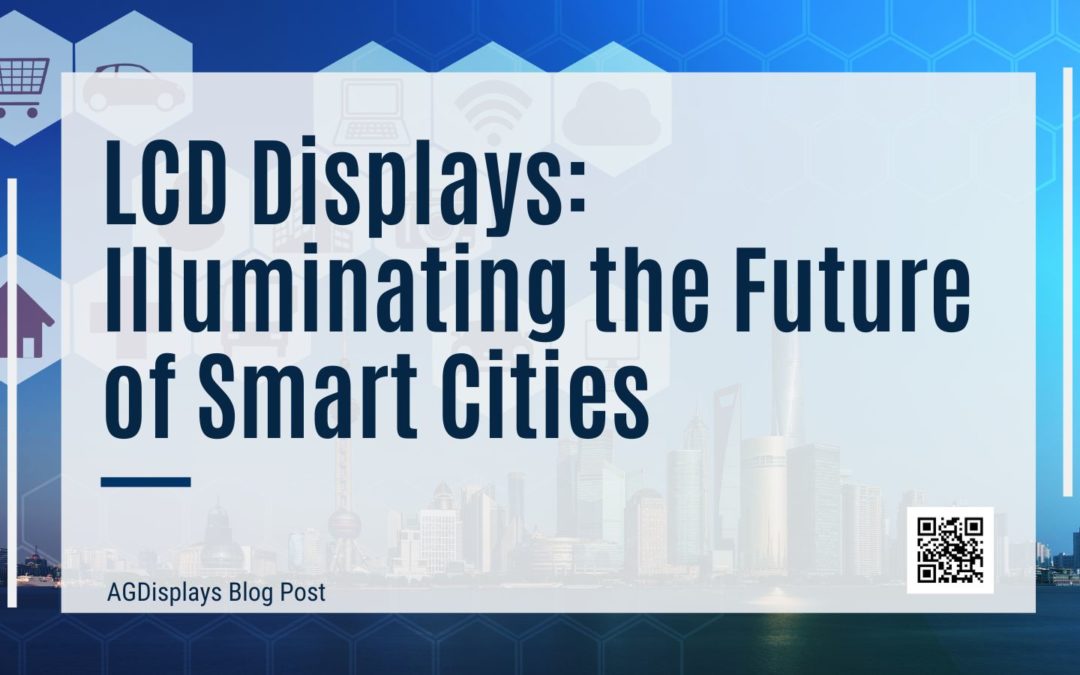The relentless growth of urban populations presents unprecedented challenges for city management. From traffic congestion and strained public services to safety concerns and environmental sustainability, municipalities are seeking innovative solutions. The smart city movement, a global phenomenon, integrates technology into urban infrastructure to optimize efficiency, elevate citizen experiences, and champion sustainability. At the heart of this transformation lie Liquid Crystal Displays (LCDs), playing a crucial role in modern urban environments. LCDs are indispensable tools for smart city initiatives, powering everything from real-time traffic management and public transit information to environmental monitoring, digital signage, interactive kiosks, and emergency alerts. Their versatility, energy efficiency (relative to older technologies), and ability to display dynamic, real-time data make them essential components of the connected city. However, the widespread adoption of LCDs also brings challenges, including energy consumption, e-waste generation, and sustainability considerations. As smart cities strive for greener solutions, manufacturers and urban planners are pioneering innovations in LCD technology to enhance efficiency, prolong product lifespans, and minimize environmental impact. This article explores the multifaceted role of LCD displays in shaping the future of smart cities, addressing both their potential and the challenges associated with their implementation.

The Multifaceted Role of LCD Displays in Smart Cities
Traffic Management and Smart Transportation: Paving the Way for Smoother Journeys
LCD displays are pivotal in modern traffic management systems, providing real-time updates that enhance road safety and optimize transportation efficiency.
- Variable Message Signs (VMS): These digital traffic signs display real-time information on congestion, accidents, road closures, and weather conditions, empowering drivers to make informed decisions. Smart VMS systems can dynamically adjust speed limits based on traffic flow, mitigating bottlenecks and reducing accident probability. Cities deploying well-managed VMS systems have reported significant reductions in travel times and emissions.
- Smart Parking Displays: LCD-powered smart parking systems provide real-time information about available parking spaces. Integrated with sensor networks in parking garages and city streets, these displays guide drivers directly to open spots, reducing unnecessary driving, urban congestion, and pollution. Studies indicate that smart parking displays can reduce parking search time by up to 40%, resulting in fuel savings and lower emissions.
- Public Transit Information Screens: Digital timetables and route updates displayed at bus stops, subway stations, and train platforms empower commuters to plan their journeys effectively. These screens, often integrated with GPS and transit management software, ensure accurate departure and arrival times, leading to improved rider satisfaction and increased public transportation usage, thus reducing reliance on private vehicles.
Public Information & Wayfinding: Navigating the Urban Landscape
LCD displays simplify navigation for citizens and tourists, providing access to crucial information and facilitating interaction with the urban environment.
- Interactive City Kiosks: These self-service kiosks offer maps, event listings, business directories, and emergency contact information in public spaces. Many feature touchscreens, allowing users to search for points of interest or public services tailored to their specific needs. In cities like Barcelona and New York, interactive kiosks have significantly improved access to municipal services, tourism assistance, and real-time city updates.
- Emergency Alerts & Safety Notices: During natural disasters, severe weather events, or security incidents, LCD emergency alert systems broadcast real-time safety messages. Integrated with city-wide emergency response networks, these displays provide evacuation routes, shelter locations, and urgent updates. Research demonstrates that early-warning systems using digital signage significantly improve evacuation times and reduce casualties during emergencies.
- Digital Billboards & Advertisements: LCD-based billboards and public information displays offer a dynamic platform for sharing advertisements, government announcements, and public health campaigns. Unlike static posters, digital billboards can rotate messages, adapt to time-sensitive information, and even respond to audience engagement. Many cities leverage digital billboards to display emergency alerts, streamlining public communication.
Environmental Monitoring & Smart Energy Use: Building a Sustainable Future
LCDs are increasingly employed for real-time environmental monitoring, empowering city officials and residents to track air quality, pollution levels, and energy consumption.
- Air Quality & Pollution Displays: These screens present real-time data on air pollution levels, temperature, humidity, and CO2 emissions. Displaying this information empowers residents, particularly those with respiratory conditions, to make informed decisions about outdoor activities. Smart cities like Beijing and Los Angeles utilize air quality dashboards on public screens, providing alerts when pollution levels exceed safe thresholds.
- Energy Monitoring Dashboards: LCD panels are integrated into smart buildings, offices, and homes to monitor energy consumption. These dashboards provide valuable insights into energy usage patterns, enabling users to optimize electricity consumption. Some energy dashboards even incorporate AI-driven recommendations to reduce energy waste, contributing significantly to sustainability goals.
- Smart Waste Management: LCD screens integrated into waste bins and recycling stations provide real-time feedback on fill levels, optimizing waste collection services. These smart bins alert sanitation workers only when they are full, minimizing unnecessary collection trips and reducing fuel consumption. Cities implementing smart waste displays have reported significant reductions in waste management costs and increased recycling rates.
Emergency Response & Public Safety: Ensuring Community Well-being
LCD displays are instrumental in delivering critical safety information to the public quickly and efficiently.
- Disaster Warning Systems: These systems leverage LCD screens to display severe weather warnings, earthquake alerts, and other emergency instructions. Integrated with government agencies, these signs provide instantaneous updates, reducing response times and improving public safety. The implementation of LCD-based disaster warning systems has been credited with saving lives during hurricanes, wildfires, and floods.
- Smart Surveillance Integration: LCD displays are used in law enforcement command centers, enabling officers to monitor live security camera feeds, license plate recognition data, and crime reports in real time. Smart surveillance displays enhance coordination of emergency responses and dynamic tracking of security threats.

The Future Economics of LCDs in Smart Cities: A Shifting Landscape
The economic landscape surrounding LCD deployment in smart cities is dynamic, influenced by technological advancements, evolving market forces, and increasing societal emphasis on sustainability. Several key trends are shaping the future economics of LCDs in this sector:
- Decreasing Hardware Costs: As manufacturing processes improve and economies of scale are realized, the cost of LCD panels themselves is generally decreasing. This trend makes LCD technology more accessible for budget-conscious municipalities, facilitating wider deployment across various smart city applications.
- Increased Integration and Reduced System Costs: The integration of LCDs with other smart city technologies, such as sensors, communication networks, and data analytics platforms, is becoming more seamless. This integration can lead to reduced overall system costs by streamlining installation, maintenance, and data management. For example, a single platform might manage both traffic flow data and the corresponding information displayed on VMS, reducing the need for separate, costly systems.
- Focus on Total Cost of Ownership (TCO): Smart city planners are increasingly focusing on the total cost of ownership rather than just the upfront hardware costs. TCO considers factors like energy consumption, maintenance, repair, and eventual replacement. This emphasis on TCO is driving demand for more energy-efficient and durable LCD solutions, even if they have a slightly higher initial price tag. Long-term cost savings from reduced energy consumption and extended lifespan can make these solutions more economically attractive.
- Emerging Business Models: New business models are emerging around LCD deployments in smart cities. For example, some cities are partnering with private companies to install and maintain LCD infrastructure, with the companies generating revenue through advertising or data services. These public-private partnerships (PPPs) can help municipalities overcome budget constraints and accelerate the deployment of smart city technologies. The data generated by smart city LCD deployments, such as traffic patterns or pedestrian flow, can also be monetized, creating new revenue streams for cities.
- Sustainability Incentives and Regulations: Government incentives and regulations promoting energy efficiency and e-waste reduction are playing a growing role in the economics of LCDs. Subsidies for energy-efficient displays or regulations mandating responsible recycling can influence purchasing decisions and encourage the adoption of more sustainable solutions. The increasing cost of e-waste disposal and the potential for fines related to environmental non-compliance further strengthen the economic case for longer-lasting, more easily recyclable displays.
- The Rise of “Smart” LCDs: Future LCDs in smart cities are likely to be more “intelligent,” incorporating features like built-in processors, wireless connectivity, and advanced sensors. These smart LCDs can collect and process data locally, reducing the need for centralized data processing infrastructure and potentially lowering overall system costs. They can also offer more interactive and personalized experiences for citizens.

Challenges of LCD Deployment in Smart Cities: Addressing the Hurdles
Despite their numerous advantages, LCD displays present challenges that must be addressed for widespread and sustainable adoption.
- High Energy Consumption: Outdoor LCDs require high brightness to remain visible in direct sunlight, leading to increased electricity consumption. Solutions such as auto-dimming sensors and solar-powered LCDs are crucial for mitigating energy usage.
- E-Waste and Sustainability Issues: As LCDs age, they contribute to the growing problem of electronic waste. Recycling and refurbishment programs are essential to extend the lifecycle of LCD screens and recover valuable materials.
- Initial Installation and Maintenance Costs: Large-scale LCD infrastructure requires substantial investment and regular maintenance. Public-private partnerships can help offset costs and ensure cost-effective deployments.
AGDisplays’ Role in Smart City LCD Solutions: A Partner in Progress
AGDisplays, a recognized leader in LCD enhancement, repair, and custom display solutions, plays a crucial role in enabling the successful integration of LCD technology within smart city environments. Their expertise extends beyond simply providing displays; they offer a comprehensive suite of services and solutions specifically tailored to the unique demands of smart city applications. Here’s a more detailed look at how AGDisplays contributes to the evolution of smart cities:
- Extended Display Lifespan through Ruggedization and Optical Bonding: Smart city LCDs, particularly those deployed outdoors, face harsh environmental conditions, including extreme temperatures, sunlight, moisture, and vandalism. AGDisplays’ optical bonding solutions significantly improve LCD durability by eliminating the air gap between the cover glass and the LCD panel. This process reduces internal reflections, enhances contrast, and, most importantly, protects the display from environmental damage, increasing its lifespan and reducing the need for frequent replacements. Furthermore, AGDisplays offers ruggedized display designs that incorporate robust materials and construction techniques to ensure that public-facing LCDs can withstand the rigors of daily use and challenging weather conditions. This focus on durability translates to long-term cost savings for municipalities by minimizing maintenance and replacement expenses.
- Energy-Efficient Upgrades and Custom Backlight Solutions: Energy consumption is a major concern for smart cities. AGDisplays specializes in LED backlight upgrades, a critical component for reducing power consumption in LCDs. By replacing traditional CCFL backlights with highly efficient LEDs, AGDisplays can significantly reduce the energy footprint of LCD displays while maintaining or even improving brightness levels. They also offer custom backlight design services to meet specific energy efficiency requirements and optimize display performance for various applications. These low-power LCD solutions help cities achieve their energy efficiency goals, reduce operational costs, and contribute to a more sustainable urban environment.
- Sustainable Display Refurbishment and Lifecycle Management: As smart cities embrace circular economy principles, responsible e-waste management becomes paramount. AGDisplays provides comprehensive repair and refurbishment services to extend the life of existing LCD displays, reducing the volume of e-waste generated. By repairing and upgrading existing displays, AGDisplays helps cities avoid the environmental impact and cost associated with purchasing new units. Their recycling programs ensure that valuable materials from end-of-life displays are recovered and reused, further supporting circular economy initiatives and minimizing the environmental footprint of smart city technology.
- Custom Display Solutions for Diverse Applications: Smart cities encompass a wide range of applications, each with its own unique display requirements. AGDisplays offers custom display solutions tailored to specific needs, whether it’s a high-brightness display for a sunny outdoor kiosk, a low-power display for a remote environmental monitoring station, or a touch-sensitive display for an interactive city information kiosk. Their engineering team collaborates with city planners and system integrators to design and manufacture displays that meet the precise requirements of each project, ensuring optimal performance and integration.
- Integration Expertise and Technical Support: Beyond providing hardware, AGDisplays offers integration expertise and technical support to assist municipalities in deploying and managing their LCD infrastructure. They can help with system design, installation, and ongoing maintenance, ensuring seamless integration of LCDs with other smart city technologies. Their technical support team is available to address any issues that may arise, minimizing downtime and maximizing the effectiveness of smart city deployments.
- Focus on Quality and Reliability: AGDisplays is committed to providing high-quality, reliable LCD solutions. Their rigorous testing and quality control processes ensure that their displays perform consistently and meet the demanding requirements of smart city applications. This focus on quality translates to reduced maintenance costs and increased longevity, making AGDisplays a trusted partner for municipalities investing in smart city technology.
By offering a comprehensive range of services, from custom design and ruggedization to energy-efficient upgrades and sustainable lifecycle management, AGDisplays is empowering smart cities to leverage the full potential of LCD technology while minimizing environmental impact and maximizing cost-effectiveness. They are not just a supplier of displays; they are a partner in building the smart cities of the future.
To learn more about AGDisplays Smart Solutions, check out our e-book.
Conclusion: Illuminating the Path Forward
LCD displays are transforming smart cities, creating more efficient, connected, and sustainable urban environments. By leveraging innovative LCD technology, cities can enhance public safety, optimize energy usage, and elevate citizen engagement. As municipalities plan for the future, the evolving economics of LCDs, driven by decreasing costs, increasing integration, and a focus on sustainability, will make these displays even more integral to the smart city landscape. Companies like AGDisplays are at the forefront, developing durable, energy-efficient, and sustainable LCD solutions that illuminate the path towards a brighter, smarter future.
Visit our Shopify Store: https://shop.agdisplays.com/

